
BioMed Central
Page 1 of 9
(page number not for citation purposes)
Journal of Immune Based Therapies
and Vaccines
Open Access
Original research
A Canadian national survey of attitudes and knowledge regarding
preventive vaccines
Paul Ritvo*1,2,3,4,5, Jane Irvine1,2,3,6,7, Neil Klar2,4, Kumanan Wilson8,
Laura Brown5, Karen E Bremner9, Aline Rinfret10, Robert Remis2 and
Murray D Krahn11,12
Address: 1School of Kinesiology and Health Sciences, York University, Toronto, Canada, 2Department of Public Health Sciences, University of
Toronto, Toronto, Canada, 3Department of Psychiatry, University of Toronto, Toronto, Canada, 4Division of Preventive Oncology, Cancer Care
Ontario, Toronto, Canada, 5Division of Epidemiology, Biostatistics and Behavioural Science, Ontario Cancer Institute/University Health Network,
Toronto, Canada, 6Department of Psychology, York University, Toronto, Canada, 7Division of Behavioural Health Sciences, Toronto General
Research Institute/University Health Network, Toronto, Canada, 8Department of Health Administration, University of Toronto, Toronto, Canada,
9Department of Medicine, Toronto General Hospital/University Health Network, Toronto, Canada, 10The Canadian Network for Vaccines and
Immunotherapeutics (CANVAC), CANVAC Coordinating Centre, Toronto, Canada, 11Clinical Epidemiology, Faculty of Medicine, University of
Toronto, Toronto, Canada and 12Clinical Epidemiology Health Policy Management and Evaluation, University Health Network and University of
Toronto, Toronto, Canada
Email: Paul Ritvo* - paul.ritvo@utoronto.ca; Jane Irvine - jane.irvine@utoronto.ca; Neil Klar - neil.klar@cancercare.on.ca;
Kumanan Wilson - Kumanan.Wilson@uhn.on.ca; Laura Brown - laura.brown@cancercare.on.ca; Karen E Bremner - kbremner@uhnresearch.ca;
Aline Rinfret - aline.rinfret@UMontreal.CA; Robert Remis - robert.remis@utoronto.ca; Murray D Krahn - murray.krahn@uhn.on.ca
* Corresponding author
preventive vaccinesattitudesknowledgenationwide Canadian survey
Abstract
Background: Vaccines have virtually eliminated many diseases, but public concerns about their
safety could undermine future public health initiatives.
Objective: To determine Canadians' attitudes and knowledge about vaccines, particularly in view
of increasing public concern about bioterrorism and the possible need for emergency
immunizations after weaponized anthrax incidents and the events of September 11, 2001.
Method: A 20-question survey based on well-researched dimensions of vaccine responsiveness
was telephone-administered to a random sample of N = 1330 adult Canadians in January, 2002.
Results: 1057 (79.5%) completed the survey. Respondents perceived vaccines to be highly
effective and demonstrated considerable support for further vaccine research. However, results
also indicate a lack of knowledge about vaccines and uncertainty regarding the safety.
Conclusions: Support for vaccines is broad but shallow. While Canadians hold generally positive
attitudes about vaccines, support could be undermined by widely publicized adverse events. Better
public education is required to maintain support for future public health initiatives.
Published: 05 November 2003
Journal of Immune Based Therapies and Vaccines 2003, 1:3
Received: 06 August 2003
Accepted: 05 November 2003
This article is available from: http://www.jibtherapies.com/content/1/1/3
© 2003 Ritvo et al; licensee BioMed Central Ltd. This is an Open Access article: verbatim copying and redistribution of this article are permitted in all
media for any purpose, provided this notice is preserved along with the article's original URL.

Journal of Immune Based Therapies and Vaccines 2003, 1http://www.jibtherapies.com/content/1/1/3
Page 2 of 9
(page number not for citation purposes)
Background
Immunization against infectious disease has probably
saved more lives than any other public health interven-
tion, apart from the provision of clean water [1]. Vaccina-
tion programs are among the most effective public health
initiatives undertaken, credited with eliminating small
pox, virtually eliminating polio and substantially reduc-
ing the illness burden of infectious diseases such as diph-
theria, pertussis, and measles [1]. Vaccine technology has
recently been profiled in the international press with
emphasis on research aimed at new vaccines for Human
Immunodeficiency Virus (HIV) and cancer [2,3]. Terrorist
threats have also focused attention on anthrax and small-
pox vaccines as one means of public protection against
bioterrorism [4,5].
While vaccines have provided benefits, the effectiveness of
new and existing programs depends on the acceptance of
the public, which is increasingly challenged by concerns
about safety, particularly given possible findings linking
multiple sclerosis and the hepatitis B vaccine, and allega-
tions of linkage between autism and measles, mumps and
rubella vaccines [6,7]. While most public health officials
and epidemiologists believe these fears to be unfounded,
such fears undermine the effectiveness of vaccination pro-
grams. To provide an empirical basis for public education
efforts, we undertook a national survey to better under-
stand the public's acceptance of current and potential
future vaccinations and to explore their attitudes and lev-
els and types of knowledge.
Methods
Survey Instrument
The survey instrument consisted of 20 statements to
which subjects could respond "strongly agree", "agree",
"neither agree nor disagree", "disagree", "strongly disa-
gree", and "don't know enough to comment". Item selec-
tion was based on review of past surveys of attitudes and
knowledge in relation to vaccines [8–23], current infor-
mational materials for the Canadian public [24,25] and
expert review of item alternatives. The review panel con-
sisted of 2 health psychologists, 2 internal medicine spe-
cialists, 4 research immunologists, 1 public health
oriented epidemiologist, 1 survey research expert and 2
nurses. Instrument content was primarily devoted to 8
domains that figured prominently in past surveys and
informational materials. These domains were: vaccine
safety [8–21]; vaccine efficacy [8–21]; vaccine knowledge
[8–21]; vaccine acceptability [8–23]; anxiety about vac-
cines [8,10–21]; and opposition to vaccines [8,20,23]. In
addition we focused on attitudes towards vaccine research
and perceived religious barriers to use of vaccination. One
indication of the centrality of the dimensions focused on
in this study, particularly in the Canadian context, is that
vaccine safety, efficacy and knowledge are the first topics
addressed in the current Canadian Immunization Guide
[24] and in Your Child's Best Shot – A Parent's Guide to
Vaccination [25] (Canadian Pediatric Society), arguably
two central sources of vaccine information and promo-
tion in Canada. In addition to the centrality of these
dimensions in prior vaccine research, our rationale was
that if education and promotion efforts are focused in
these areas, it is important to derive nationwide Canadian
data about these dimensions of vaccine response.
Population sampling
The survey was carried out between January 4 and Febru-
ary 4, 2002 on a randomized sample of 1330 Canadian
adults, aged 18 years and older. There were separate rand-
omizations for the 3 largest cities, Montreal, Toronto, and
Vancouver, with percent population per province and per
city representative of Statistics Canada regionalized gen-
der data (of the population > or = to 18 years in 2000–
2001). The sampling process was performed by Canada
Survey Sample (CSS), a selection engine that generates
random samples of residential telephone numbers. The
CSS maintains a comprehensive list of all populated
exchanges across Canada, and is updated regularly. The
CSS randomly generated 4-digit suffixes for these
exchanges, in proportion to the percent population of the
individual exchanges. As each suffix was generated, it was
compared to the database of existing, known phone num-
bers. If it matched a listed phone number, it was placed in
the 'valid number' file. If it did not, it was placed in the
'orphan' file. The valid number file was used as the pri-
mary calling list and was supplemented with numbers
from the orphan list. As was true for the randomized pro-
cedure described above, numbers were chosen from the
orphan list in proportion to the percent population of the
exchanges. Since a significant number of "not-in-service"
numbers were encountered, a slightly higher than normal
ratio of respondents were sampled to ensure timely and
efficient survey fieldwork [26].
Statistical Methods
The data were initially weighted by region and gender
because the near-perfect regional and gender representa-
tion achieved by interviewing alone was disturbed by the
process of refusal conversions, which were undertaken to
achieve a high response rate. In this survey, the demo-
graphic characteristics of the sample and the responders
so closely approximated the true population that use of
weights did not alter results and, accordingly, weights
were not employed in analyses.
Descriptive statistics (frequencies, means, standard devia-
tions) were calculated to characterize the respondents and
their survey responses. As 18 years was the minimum age
for inclusion, the 6 respondents who gave 1984 as their
year of birth were presumed to be 18 by February 4, 2002.

Journal of Immune Based Therapies and Vaccines 2003, 1http://www.jibtherapies.com/content/1/1/3
Page 3 of 9
(page number not for citation purposes)
Categories of age were constructed, based on quartiles of
the distribution, for categorical analyses. Relationships
between variables were evaluated by employing chi-
square, correlational, ANOVA, MANOVA and forwards
stepwise logistic regression analyses using SPSS for Win-
dows [27].
Results
Of the individuals contacted by telephone, 79.5% agreed
to complete the survey (N = 1057). Demographic charac-
teristics of the 1057 respondents are shown in Table 1.
Year of birth was not provided by 30 respondents. The
mean age of respondents was 44.78 years, with females (n
= 513) slightly older (mean ± SD age = 45.9 ± 16.8 years)
than males (n = 514, 43.72 ± 15.56, p < 0.05). More males
(n = 321) were employed full-time than females (n =
213), while more females (n = 236) than males (n = 157)
were unemployed (p < 0.001). Unemployed respondents
were older (53.64 ± 16.2 years) than those working full-
time (40.2 ± 10.15) or part-time (36.08 ± 14.91, p <
0.001).
Responses to Survey Items
Responses are shown in Table 2. In general, the responses
of subjects reflected positive attitudes. However,
Table 1: Demographic Data (N = 1057 respondents)
N%
Gender Male 525 49.7
Female 532 50.3
Age (Mean (SD)) (n = 1027) 44.78 (16.20)
Marital status Single (never married) 294 27.8
Married or common-law 620 58.7
Widowed 52 4.9
Separated 25 2.4
Divorced 49 4.6
Refused 17 1.6
Children Yes 721 68.2
No 327 30.9
Refused 9 0.9
Residence Urban 698 66.0
Rural 338 32.0
Refused 21 2.0
Province/City Newfoundland 21 2.0
Nova Scotia 37 3.5
Prince Edward Island 4 0.4
New Brunswick 31 2.9
Quebec (excl. Montreal) 137 13.0
Ontario (excl. Toronto) 233 22.0
Manitoba 42 4.0
Saskatchewan 39 3.7
Alberta 101 9.6
B.C. (excl. Vancouver) 77 7.3
Montreal 115 10.9
Toronto 157 14.9
Vancouver 63 6.0
Highest Education Less than high school 157 14.9
High school completed 307 29.0
Some college/university 132 12.5
College diploma 186 17.6
University undergraduate degree 200 18.9
University Masters degree 51 4.8
University Doctorate degree 9 0.9
Refused 15 1.4
Employment Full-time 534 50.5
Part-time 122 11.5
Not presently employed 393 37.2
Refused 8 0.8

Journal of Immune Based Therapies and Vaccines 2003, 1http://www.jibtherapies.com/content/1/1/3
Page 4 of 9
(page number not for citation purposes)
Table 2: Responses (%) to Survey (N = 1057)
Strongly
agree
Agree Neither
agree nor
disagree
Disagree Strongly
disagree
Don't know
enough to
comment
Refused
Q1: The vaccines available are very carefully
and consistently tested for safety
16.8 50.3 4.5 4.4 0.9 22.9 0
Q2: The safeguards used in making vaccines
are slack and ineffective
2.67.94.833.510.640.4 0.2
Q3: Vaccines are amongst the most effective
and least costly forms ofmedical treatment
ever created
17.2 41.5 4.5 8.6 1.1 26.6 0.4
Q4: I don't really know what a vaccine is and
how it works
2.6 19.4 3.2 43.8 23.8 6.9 0.2
Q5: A vaccine is a medical treatment in
which dangerous viruses and bacteria are
killed or modified and then put into your
body
12.6 45.3 3.4 9.7 2.2 26.6 0.2
Q6: The reason vaccines are given regularly
to children is that they result in lifelong
protection from several serious diseases
34.9 48.9 3.3 5.3 1.2 6.3 0
Q7: A vaccine can give you a serious case of
the very same disease you're trying to avoid
4.9 24.7 7.4 31.0 8.6 23.2 0.2
Q8: The government should invest more
money in the development of vaccines for
serious diseases like AIDS, Hepatitis, and
Cancer
46.8 40.0 2.6 4.5 1.0 4.8 0.2
Q9: The idea of taking a newly developed
vaccine, even if it has been carefully safety
tested, makes me very anxious
8.8 33.8 8.2 30.7 8.8 9.5 0.3
Q10: Vaccines have, over the years,
produced many more health benefits than
health troubles
33.6 45.8 3.4 4.4 0.6 12.3 0
Q11: An increasing number of people are
becoming anti-vaccine oriented as more
information about vaccines and how they
are developed is available over the Internet
5.7 27.1 8.8 16.0 2.8 39.3 0.4
Q12: Those people who take anti-vaccine
positions are highly prejudiced and ill-
informed, scientifically
10.2 28.3 7.7 21.9 6.0 25.4 0.7
Q13: In view of the international situation
and the risks of bioterrorism, I would
readily take an anthrax vaccine
20.2 45.2 4.5 15.8 2.9 10.9 0.5
Q14: In view of the international situation
and the risks of bioterrorism, I would
readily take a smallpox vaccine
15.5 35.1 7.4 21.3 6.1 14.2 0.4
Q15: In view of the international situation
and the risks of bioterrorism, I would
readily take whatever vaccine was
promoted by the national government and
its medical advisors
15.2 40.6 9.6 20.5 4.5 9.2 0.4
Q16: I intend to take an influenza vaccine
this year, or I have already done so
21.3 24.3 4.3 34.2 11.4 4.0 0.6
Q17: If it were available, I would readily take
a vaccine to prevent HIV-AIDS
31.6 5.6 5.2 15.6 4.8 6.6 0.6
Q18: If it were available, I would readily take
a vaccine to prevent Hepatitis C
26.2 46.4 5.5 9.2 1.9 10.6 0.3
Q19: I have religious beliefs that prevent me
from taking vaccines
0.6 2.1 2.5 54.4 46.5 2.5 0.6
Q20: I don't really know why I received
vaccines as a child
5.2 18.4 2.1 41.5 25.3 6.4 1.0

Journal of Immune Based Therapies and Vaccines 2003, 1http://www.jibtherapies.com/content/1/1/3
Page 5 of 9
(page number not for citation purposes)
significant proportions demonstrated negative attitudes,
insufficient knowledge and uncertainty.
Vaccine Safety
On the question, 'The safeguards used in making vaccines are
slack and ineffective', 40.4% indicated insufficient knowl-
edge, 4.8% indicated uncertainty, while 10.5% agreed
with the negatively worded statement. A positively
worded question, 'The vaccines available are very carefully
and consistently tested for safety', yielded similar results as
22.9% indicated insufficient knowledge, 4.5% indicated
uncertainty while 5.3% indicated negative attitudes to the
question.
Vaccine Knowledge
The most direct assessment of insufficient knowledge was
evident in responses to two items – 'I don't really know what
a vaccine is and how it works' and 'I don't really know why I
received vaccines as a child'. Nearly one-third of respond-
ents (32.1%) endorsed these items in ways indicating
insufficient knowledge, uncertainty, or an inability to
comment.
Vaccine Acceptability
The idea of taking new vaccines seemed to provoke anxi-
ety as indicated by responses to the item, 'The idea of taking
a newly developed vaccine, even if it has been carefully safety
tested, makes me very anxious'. In all 42.6% of subjects
'agreed' (33.8%) or 'strongly agreed' (8.8%) with this
item. When the acceptability of specific vaccines was sur-
veyed the most acceptable potential vaccine was hepatitis
C with 72.6% of respondents affirming acceptability. A
potential HIV-AIDS vaccine was nearly as acceptable, with
67.2% affirming acceptability. Less acceptable were vac-
cines associated with potential bio-terrorist threats as only
50.6% indicated an anthrax vaccine was acceptable while
65.4% indicated a small pox vaccine was acceptable. It
was also evident that government endorsement of terror-
ist – protective vaccines was not a definitive influence in
promoting acceptability as only 55.8% of respondents
would take 'whatever vaccine was promoted by the national
government and its medical advisors'.
Vaccine Efficacy
In terms of general views of vaccine efficacy, subjects were
highly supportive with 79.4% endorsing either 'agree'
(45.8%) or 'strongly agree' (33.6%) to the item 'Vaccines
have, over the years, produced many more health benefits than
health troubles' while 58.7% endorsed either 'agree'
(41.5%) or 'strongly agree' (17.2%) to the item 'Vaccines
are amongst the most effective and least costly forms of medical
treatment ever created'.
Opposition to Vaccines
Over one-third of subjects indicated awareness of organ-
ized opposition to vaccination programs with 37.2 %
endorsing either 'agree' (27.1%) or 'strongly agree' (5.7%)
to the item 'An increasing number of people are becoming
anti-vaccine oriented as more information about vaccines and
how they are developed is available over the internet'. A major-
ity of subjects (61.7%) were reluctant to dismiss anti-vac-
cine positions, evidenced in their response to the item,
'People who take anti-vaccine positions are highly prejudiced
and ill-informed, scientifically' (27.9% – disagree or strongly
disagree, 25.4% – don't know enough to comment, 7.7%
– neither agree nor disagree).
Vaccine Research
The value of vaccine research was strongly supported, with
86.8% positively endorsing the item, 'The government
should invest more money in the development of vaccines for
serious diseases like AIDS, Hepatitis, and Cancer' (strongly
agree – 46.8%, agree – 40.0%).
Religious Barriers
There was little evidence that religious beliefs presented a
barrier to vaccination. Only 2.7% of respondents
endorsed the item, 'I have religious beliefs that prevent me
from taking vaccines'.
Associations of Responses
Vaccine Acceptability
Of the 28 people who said that religious reasons pre-
vented them from taking vaccines, 9 (32%) agreed to take
all 6 vaccines described, 7 (25%) agreed to take 5 and only
4 (14.3%) agreed to take none. Of the demographic vari-
ables, only employment status was related to willingness
to take vaccines. Respondents who were not presently
employed agreed to take 3.75 (±1.86) of the vaccines but
those working full-time agreed to take 3.4 (+1.9) (p <
0.05).
Overall Attitudes
We categorized responses to each question as "positive",
"negative", or "don't know/undecided", with "positive"
indicating vaccine acceptance, "negative' indicating vac-
cine opposition and "don't know/undecided" indicating
neither agreement nor disagreement, or insufficient
knowledge to comment. We calculated the number of sur-
vey questions for which each subject responded "posi-
tive", "negative", and "undecided/don't know", as a
summary measure of attitudes towards and knowledge of
vaccines. Table 3 shows the effects of demographics on the
number of vaccine-positive, vaccine-negative, and don't
know/undecided responses. Females were less knowl-
edgeable and more frequently undecided than males and
there was a significant linear trend towards more vaccine-
positive, fewer vaccine-negative and fewer don't know/

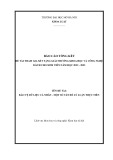
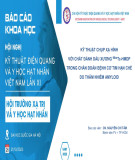

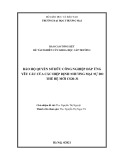
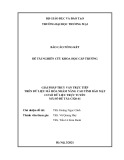
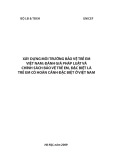
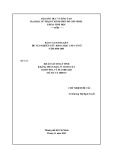
![Vaccine và ứng dụng: Bài tiểu luận [chuẩn SEO]](https://cdn.tailieu.vn/images/document/thumbnail/2016/20160519/3008140018/135x160/652005293.jpg)
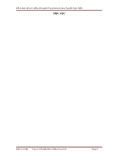
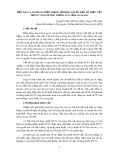





![Báo cáo seminar chuyên ngành Công nghệ hóa học và thực phẩm [Mới nhất]](https://cdn.tailieu.vn/images/document/thumbnail/2025/20250711/hienkelvinzoi@gmail.com/135x160/47051752458701.jpg)









